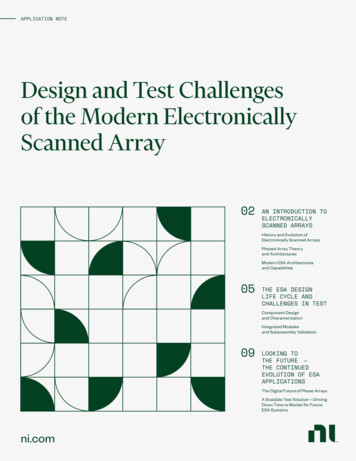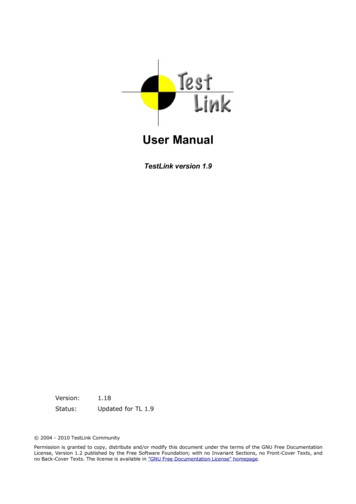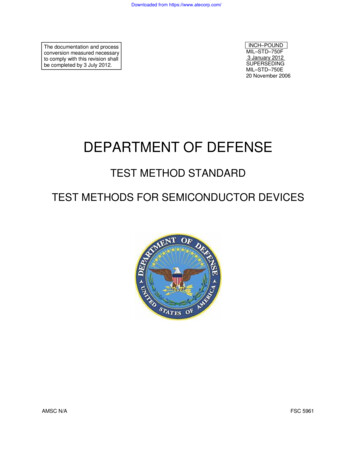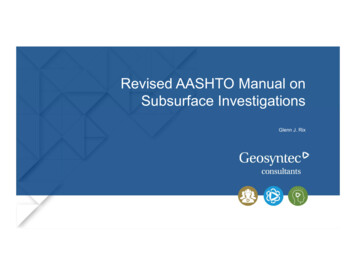
Transcription
APPLICATION NOTEDesign and Test Challengesof the Modern ElectronicallyScanned Array02AN INTRODUCTION TOELECTRONICALLYSCANNED ARRAYSHistory and Evolution ofElectronically Scanned ArraysPhased Array Theoryand ArchitecturesModern ESA Architecturesand Capabilities05THE ESA DESIGNLIFE CYCLE ANDCHALLENGES IN TESTComponent Designand CharacterizationIntegrated Modulesand Subassembly Validation09LOOKING TOTHE FUTURE —THE CONTINUEDEVOLUTION OF ESAAPPLICATIONSThe Digital Future of Phase ArraysA Scalable Test Solution—DrivingDown Time to Market for FutureESA Systemsni.com
DESIGN AND TEST CHALLENGES OF THE MODERN ELECTRONICALLY SCANNED ARRAYPhased arrays are increasingly leveraged as the foundational RF architecture in a wide variety of applications inaerospace and defense. These electronically scanned arrays (ESAs) are constantly evolving with cutting-edgecapabilities, requiring additional scrutiny throughout design, characterization, and production. A scalable andnimble test solution is required to handle and validate a multitude of scenarios, ranging from parametric test ofcomponents to validation of systems.This application note will cover the uses and trends related to the modern ESA. It will relate these design trends tocorresponding test challenges and needs, pointing out where new capabilities may be required. While addressingthe development life cycles of the components, modules, and subassemblies that act as building blocks of the finalsystem, the key test requirements will be summarized and explained and recommended solutions proposed. Finally,this application note will briefly examine the future of ESA architectures and map them to the latest developmentsin test systems.An Introduction to ElectronicallyScanned ArraysHistory and Evolution of ElectronicallyScanned ArraysTraditionally, common electromagnetic applications such as radarand communications relied on a singular antenna integrated with atransmitter and a receiver. For dynamic applications, these antennaswould be mechanically rotated or positioned to steer the radiatedbeam of RF energy at the target. For example, a search radarsystem antenna would be rotated over a determined horizontal axis,covering a spatial grid at a certain scan rate based on the speed ofthe mechanical system. In another example, a communications link isestablished by repositioning an antenna, as pictured in Figure 1, on itsvertical axis to track an orbiting satellite.With the advances in solid-state electronics and the introduction ofnewer components that provide a controllable delay of the RF signal,it became possible to replace the traditional mechanical positioningof antennas with electronically steered RF energy. The fundamentalconcept was to take a common RF signal and split it over multipleantenna elements, each with its own delay or phase shift.The resulting radiation pattern of these transmitted signals wouldresult in focused energy in a particular direction due to constructiveinterference and attenuated energy in other directions fromdeconstructive interference. By electronically manipulating thesephase offsets on each element, the interference pattern could becontrolled, resulting in a steerable wavefront. The development ofthis technology was primarily driven by the need for more capableground-based RADAR systems in the 1960s.FIG1A Traditional Parabolic Antenna with Mechanical Positioning to Trackor Target a Satellite in Orbitni.com02
DESIGN AND TEST CHALLENGES OF THE MODERN ELECTRONICALLY SCANNED ARRAYAs solid-state technology has evolved into smaller, more efficient, andcheaper components, the use of phased array architectures becameprevalent and more capable, leading to modern radar systems suchas the AN/MPQ-53, as seen in Figure 2, used in Patriot surface-to-airmissile batteries.Today, ESA-based systems are found in a variety of applications,from ground-based systems to air, sea, and space-basedplatforms. Beyond radar, phased arrays can be found in adjacentelectromagnetic applications such as imaging, communications, andthe broader electronic warfare theatre.Phased Array Theory and ArchitecturesThe electronically scanned array can be segmented into four primarytypes. The first and original ESA is the passive electronically scannedarray (PESA). In a PESA-based system, a single receiver and transmitter,commonly referred to as the receiver exciter (REx), is paired with amultielement solid-state array. Each radiating element contains a localizedphase shifter module. When transmitting, the signal is amplified anddistributed evenly across the array, with each copy being delayed byprogramming a frequency dependent phase shift. The independentlydelayed signals form again as a radiated wavefront with constructiveinterference, resulting in an amplified signal propagation in a knowndirection. This multielement control results in the ability to manipulate thecorresponding wavefront to and from the natural boresight of the antenna,as seen in Figure 3.FIG2An AN/MPQ-53 Ground-Based Radar System Based on a ModernPassive Electronically Scanned Array (PESA) Architecturescalability of the system is limited. The transmitter, for example,largely relies on traditional high-power active elements such as aklystron or magnetron, driving the cost and size of the resulting array.On the receive side, the lossy signal paths between the element andthe receiver reduce the effective dynamic range and potentiallylimit the sensitivity of the system. This results in a reduced totalnumber of radiating elements. As technologies have evolved andthe application requirements for ESA missions have become morecomplex, there has been a shift to develop the second fundamentalarchitecture—the active electronically scanned array (AESA).Since the PESA architecture relies on a single transmitter and receiver todrive and receive from multiple elements, the effectiveness andScanning PatternSteered BeamReceiverReceiverExciterExciterFIG3Left: A typical PESA block diagram.Right: By programming each element with a frequency dependent phase offset, the individually delayed signals result in a directionally steered wavefront.ni.com03
DESIGN AND TEST CHALLENGES OF THE MODERN ELECTRONICALLY SCANNED ARRAYThe final common phase array type removes the analog phaseshifter capability and replaces it entirely with digital beamforming. Thisarchitecture, pictured in Figure 5, typically integrates a REx with eachradiating element. The fully digital beamforming array provides severalkey benefits, including flexibility, multibeam support, and improvedreliability via fully redundant signal chains per element. These advantagescome with corresponding challenges related to the complexity of thedesign, such as synchronization requirements between channels, costof implementing a full signal chain, and the volume of digital data from theaggregate array.Modern ESA Architecturesand CapabilitiesWith the introduction of ESAs, including the PESA, AESA, and digitalbeamformers, a wide variety of electromagnetic applications andmissions have been explored and enhanced. These applications rangefrom broadband communications, high-resolution imaging and radar, andthe cognitive multifunction domain of electronic warfare.ExciterFIG4The active electronically scanned array (AESA) implements analogbeamforming with a dedicated transmit receive (T/R) module perantenna element.DACDACADCDACADCDigital BeamformerA third type of ESA architecture that is being introduced in moderncommunication and radar systems is commonly referred to as a hybriddigital beamforming phased array. This is usually implemented bycombining multiple instances of an AESA with digital beamforming on thebackend, as pictured in Figure 5. Each AESA subarray consists of a singleREx and a defined power of 2 multiple of T/R module enabled elements.These subarrays are then integrated into the full array along with a digitalbeamforming backend. The resulting architecture supports an aggregatewavefront that has been digitally synthesized, or clusters of independentbeams leading to multimode or multifunctional application capabilities.ReceiverDigital BeamformerThe AESA compliments the primary transmitter and receiver by placingactive components closer to the radiating elements in the array, asseen in Figure 4. This advancement has primarily been driven by moreeffective active solid-state devices built on gallium arsenide (GaAs)and gallium nitride (GaN) processes. The passive phase shifter hasbeen replaced with an integrated transmit receive (T/R) module thatcontains an optimized power amplifier (PA) for the transmit mode anda highly sensitive low-noise amplifier (LNA) for the receive mode. Theprogrammatic delay or phase shift can be integrated in this T/R moduleor further back in the signal distribution network. Modern communicationarrays typically integrate phase control, gain control, and signal distributionin an integrated element called an analog beamformer. The integration ofthe various fundamental functions of an AESA into core components andmodules allows for highly scalable array topologies and a higher degree ofoptimization for the end application of the system.ADCDACDACADCDACADCADCFIG5Left: A hybrid digital beamforming array combines multiple AESAsubarrays with a digital beamformer to create an aggregate system.Right: A fully digital beamforming array implements a REx with eachT/R module and array element.The communications industry has been advancing at a steady ratetowards better global coverage and higher data throughput. Whether it’sthe upcoming 5G telecommunications or the latest in satellite datalinks,the ESA serves as the fundamental electromagnetic workhorse. Thewideband, multichannel capabilities of the ESA effectively correctredundancies and errors in remote locations versus throughputand data rates when the environment is free from obstacles andinterference. Modern datalink transmitters can be digitally steered totrack the orbits of communication satellites, providing longer and higherfidelity contacts. In today’s 5th and 6th generation fighter programs,the AESA tracking radar is the centerpiece of the electromagneticcapabilities. These systems range from hundreds to thousands of activeradiating elements with the ability to dynamically switch detection modessuch as a synthetic aperture radar (SAR) used for high-resolution imagingor precision detection and tracking.ni.com04
DESIGN AND TEST CHALLENGES OF THE MODERN ELECTRONICALLY SCANNED ARRAYSome next generation AESA arrays can allocate different subarrays withmultifunction capability, allowing for adaptive solutions to the complexelectromagnetic tactical environment.The ESA plays a role in electronic warfare as well, primarily augmentingcapabilities in the electronic attack (EA) and electronic protect (EP)domains. On one side of the electromagnetic theatre, modern AESAradars are capable of advanced, built-in protection features, allowingfor adaptive and robust wartime capabilities. Opposite this, modern EAsystems can leverage ESA architectures to implement more capablejamming solutions.The ESA Design Life Cycleand Challenges in TestWhether it’s for radar or satellite communications, developing an ESA is amultistep process that starts with the design or selection of fundamentalcomponents. That initial step is followed by integration and validation ofthose components into functional modules. Lastly, system level verificationoccurs after the modules are integrated into the final array. Each stageconsists of key modeling, characterization, and ultimately production testactivities, with correlation across the life cycle being paramount.Component Designand CharacterizationThere are a wide range of components that go into the modules andsubassemblies of an ESA-based system, including DC power suppliesand regulators, passive signal conditioning and filters, and active RFcomponents. Validating the performance of these components overtime, temperature, and potentially under the application conditions iscrucial to ensure system performance and prevent failures later in thedevelopment cycle.Given the advances in solid-state processes, RF components specificallyare becoming more cutting edge, with wider RF performance capabilities,increased efficiency, and smaller form factors. PAs, LNAs, and frequencytranslating mixers are fundamentally driving the capabilities and scale ofthe modern ESA, especially within newer AESA architectures. To ensureproper system design and reduce time to market, it’s becoming evenmore important to validate performance early and drive correlation withboth design models and the modules and systems they’re eventuallyintegrated into—connecting design, validation, and test throughout theproduct life cycle.Production & MaintenanceFirstRunTest RequirementsRequirementsBuild VehicleFirst ArticleFeedbackSystemDesignFullProductionDepot TestSystem StandupTests PerformedDefinition & DesignModel-in-the-Loop TestRapid Control ProtoypingSoftware-in-the-Loop TestProcessor-in-the-Loop TestIntegrateSystemsTest & IntegrationDefinitionand entDesignBuildComponentsTest andIntegrationHardware-in-the-Loop TestPhysical TestSystem Integration Test System Level Vehicle LevelField TestProduction & MaintenanceAcceptance TestingMRO TestingCode GenerationFIG6A typical product life cycle. Increased design complexity and application requirements are accelerating the need for better correlation across all stagesof design, validation, and test.ni.com05
DESIGN AND TEST CHALLENGES OF THE MODERN ELECTRONICALLY SCANNED ARRAYAt its core, an optimized test plan and solution for ESA component characterization must ensure that the basic RF and DC parameterscan be measured to validate the component back to its design or provided specification sheet. These parameters typically includemeasurements such as return loss, gain, phase, noise figure, linearity, and compression. Depending on the design of the DUT, the stagein development (that is, on wafer versus packaged), and the end application of the ESA system, the stimulus used for these fundamentalmeasurements may vary in complexity. This could include single or multitone CW signals and more complicated pulsed waveforms withtiming information. To meet this challenge, the test equipment and software selected must be versatile enough to support a wide varietyof waveforms and corresponding measurements.FIG7A typical validation bench or automated test system includes a wide variety of RF, DC, and digital instrumentation. Depending on specific capabilities, vendorcompatibility, and software control, integration of the various instruments into a cohesive test system can be challenging.To correlate to the end use of the ESA system, it may also bevaluable to perform application specific validation even at thecomponent level. Historically, these tests have been performedat the system level in a range test so that the full signal path andantenna can be validated. Given that modern ESA architecturescan include hundreds or thousands of radiating elements, all ofwhich would contribute to the resulting performance, it may notbe cost or time effective to build an entire system.As such, the ability to support application-based measurementsin addition to fundamental RF parameters is highly valuablewhen choosing your test solution. For instance, a PAdesigned for a T/R module in an AESA radar may be furthercharacterized by measuring the pulse-to-pulse stability. Thismeasurement analyzes the stability of the DC or RF signalwith respect to amplitude and phase, ensuring the deviceunder test (DUT) is stable over time and temperature undermore realistic conditions.ni.com06
DESIGN AND TEST CHALLENGES OF THE MODERN ELECTRONICALLY SCANNED ARRAYThe RF measurement is particularly challenging given thesensitivity to amplitude and phase. This results in the needfor a highly linear, phase coherent stimulus and responsesystem to ensure that the test solutions measurement flooris significantly better than the DUT. Depending on the type ofpulsed signal used, being able to scale from narrow to widemeasurement bandwidth is also important while maintainingoptimal dynamic range.For communication applications, it may be pertinent to usewideband modulated signals to validate the DUT. For example,a common measurement for wireless communicationscomponents is noise power ratio (NPR). In this measurement,the device is stimulated by a wideband noise or multitone signalto measure the dynamic range of a quiet channel while thereis energy in adjacent channels. This is especially important forcomponents used in ESA systems deployed to satellites giventhe need to maximize capability while minimizing the powerdraw of the system. To drive towards power efficiency, it’s idealto operate the active components as close to saturation aspossible. NPR provides an indicator of how well the DUT willoperate under these conditions.Integrated Modules andSubassembly ValidationOnce individual components are designed and validated, they’re oftenintegrated into modules or subassemblies that can then be scaled upto the final ESA system architecture. These modules usually provide aspecific function or group of functions key to how the ESA will work. Asthe level of integration increases, so does the complexity of test. Thesemodules often include multiple signal paths and digital control, multiplyingthe number of test points required for performance validation andrequiring a more complicated set of test instrumentation.One of the most common modules, particularly in the latest and greatestAESA systems, is the T/R module. This module combines a high powertransmit path with a highly sensitive receive path in a single front endgenerally designed to interface directly to a radiating element. These twopaths either operate in parallel with isolating and directional elements suchas circulators and limiters or in a time multiplexed manner with solid-stateswitches. In addition to the core functionality, other components such asprogrammable amplitude and phase control can also be included, addinganother layer of digital control to the DUT. Although the test plan andmeasurements are often very similar to the fundamental RF componentvalidation discussed previously, these tests must be integrated andsynchronized with the digital control, and the coverage must increase toaccount for the various programmable states of the module.VSTVSAVSAPADMMSMUPower SupplyVSTSMUDigitalHS SerialDMMSMUPower SupplyHS SerialSMUDigitalSwitchPXI SystemSwitchPXI SystemHPAMMICLNAComponentFIG8To reduce complexity and improve scalability, a modular, platformbased test system can be implemented to meet the wide range ofI/O instrumentation needs and measurement capabilities. Softwareintegration, triggering and synchronization, and data movementchallenges are solved by consistent and well-defined interfaces.ModuleFIG9Building on the platform-based test system approach, the solutionfor testing a component such as a PA can be scaled up to includeintegrated digital control and expanded RF or DC I/O. This allows foreasily transitioning to test a more complex DUT, such as a T/R module.ni.com07
DESIGN AND TEST CHALLENGES OF THE MODERN ELECTRONICALLY SCANNED ARRAYTaking a step further toward system integration, multiple T/R modules may be combined with a signal distribution network to create a multichannelsubassembly. Combining the multiple channels with individual control of amplitude and phase provides the beam steering functionality that iscore to the ESA architecture. From here, these multichannel subassemblies can be integrated together to build out to the final element countof the system.These subassemblies also create a scaling challenge for the corresponding test solution. From an RF signal perspective, the test engineer can addswitching to the test solution to multiplex the instrumentation to the corresponding channels of the DUT.Alternatively, multiple test instruments can be used in parallel with each instrument connected to a single channel. In the first scheme, the solutionis typically optimized for cost with the potential negative side effect of being slower in test time and limited in coverage. This is particularly true whenmeasuring the interaction between multiple channels under a common stimulus. The second scheme trades off some cost optimization for theability to test all channels in parallel. Regardless of which topology is decided on, it should be noted that the digital control and synchronization of theDUT configuration with test instrumentation has also scaled in complexity, and the ideal solution must account for this.VSTHS SerialVSAPXI SystemDigitalSwitchDigitalPXI SystemHS SerialVSTADCDACSubassembly& SystemFIGVSTADCDACADCADC10VSTDACDigital BeamformerDigital BeamformerDACVSTSubassembly& SystemAt the subassembly or system functional test level, the platform-based test solution can be reoptimized to match multichannel RF interfaces, either in aswitched or parallel instrument manner.ni.com08
DESIGN AND TEST CHALLENGES OF THE MODERN ELECTRONICALLY SCANNED ARRAYLooking to the Future—the Continued Evolutionof ESA ApplicationsPXI SystemThe Digital Future of Phase ArraysHS SerialWhile solid-state processes such as GaAs and GaN are allowing formore efficient and integrated RF front-end components and modules,there are similar investments being made in the backend of the ESAsystem as well. This includes multichannel ADCs and DACs withincreased sample rates, allowing for directly sampled RF signaling,as opposed to traditional frequency translation architectures. Theseconverters are being integrated together with cutting-edge DSP andFPGA-based backends, creating wideband, low-latency systems on achip. Ultimately, these two trends are leading to the next phase in ESAevolution—the fully digital AESA.VSTVSTVSTDACADCDACDigital BeamformerUnlike current PESA and AESA architectures that rely on a reducedset of converters and frequency translation stages feeding hundredsor thousands of antenna elements through beamformers and signaldistribution networks, the digital beamforming array attempts topair wideband transmit and receive pairs directly with the antennaelements. This allows for the amplitude, phase, and frequency controlof the signal at each element to be digitally synthesized, improvingresponse times and precision. It also enables more capable systemsfrom a multifunctional perspective, as individual or grouped channelscan be repurposed in a software-defined manner. For example, asubarray or set of digital signal chains can be configured to instantiatea communication link while the rest of the array continues to operateas a radar.VSTADCDACADCDACADCSubassembly& SystemFIG11A modular test system configured to be a virtual multichannel digitaland RF instrument. This allows for testing the scales from functionalparametric test to system validation.These benefits and capabilities also come with an increase in testsolution complexity. From an RF performance perspective, theintegration of components and digital data interfaces removestraditional test points at the component and module levels, reducingthe effectiveness of some types of test equipment. To scale the testsolution, the validation engineer will need to combine wideband RFsignal generators and analyzers with high-speed digital transceiversolutions, effectively creating a synthetic mixed I/O instrumentcapable of both digital and RF interfaces, as seen in Figure 11.ni.com09
DESIGN AND TEST CHALLENGES OF THE MODERN ELECTRONICALLY SCANNED ARRAYA Scalable Test Solution—Driving Down Time to Market for Future ESA SystemsAs we have covered in previous sections, ESA architectures and phased array systems are continuing to evolve and expand in complexity andcapability as they become adopted in a wide range of electromagnetic applications. In particular, the shift from traditional PESA and AESAarchitecture to the hybrid or fully digital beamforming phase array enables more functional and flexible multibeam capability and improved reliability.The trade-off for this enhanced system is an increase in testing complexity to properly validate the end product.To meet the demands of validating and testing these systems and applications, test solutions need to evolve from traditional program specificdesigns to a scalable, software-connected platform approach. Maximizing leverage and reuse of modular instrumentation allows for easierintegration and abstraction and smooth transitions through design validation, production, and maintenance test. It also provides the validationor test engineer the agility, as seen in Figure 12, to meet the test needs of the wide variety of DUT types and interfaces seen in the life cycleof the modern ESA ower SupplySMUSMUPXI SystemVSAModuleHS SerialSubassembly& SystemA scalable, modular test platform lends itself well to a successful test strategy for the wide range of ESA architectures and systems deployed in today andtomorrow’s electromagnetic theatre. 2021 NATIONAL INSTRUMENTS. ALL RIGHTS RESERVED. NATIONAL INSTRUMENTS, NI, AND NI.COM ARE TRADEMARKS OFNATIONAL INSTRUMENTS. 36940
A third type of ESA architecture that is being introduced in modern communication and radar systems is commonly referred to as a hybrid digital beamforming phased array. This is usually implemented by combining multiple instances of an AESA with digital beamforming on the backend, as pictured in Figure 5. Each AESA subarray consists of a single











